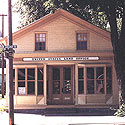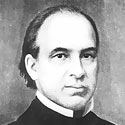The History of St. Joseph County, Michigan
Click photos below
for expanded views

| 
|
Sharing Michigan's border with Indiana, St. Joseph County is bisected by the St. Joseph River. French explorers, missionaries and fur traders who traversed the St. Joseph River Valley during the late seventeenth and eighteenth centuries, undoubtedly journeyed into St. Joseph County. In March 1680-after establishing Fort Miami at the mouth of the St. Joseph River-Rene'-Robert Cavelier Sieur de La Salle undertook the first known journey of white men across the Lower Peninsula. According to historian Charles A. Weissert, La Salle moved among the highlands between the Kalamazoo and St. Joseph River valleys on his way to the Detroit River.
The French settlement at Fort St. Joseph (present-day Niles), as well as the activities of area fur traders, kept white men interacting with Indians throughout the St. Joseph River Valley into the nineteenth century. But it was only after the opening of the Erie Canal in 1825 that St. Joseph received its first permanent white settlers.
Many of the pioneers that came to St. Joseph were responding to reports about the area's rich prairies. Stretching for miles, southwestern Michigan's prairies provided unbroken plains where a pioneer could use his plow and turn up fertile soil without having his progress deterred by the difficulties of stone and stump. According to the 1838 Michigan Gazetteer, St. Joseph's prairies were "not exceeded for their fertility, by any in this or any other State." Once these claims reached the east, settlers headed west to homestead St. Joseph. However, these pioneer journeys were tedious, and often severely tested perseverance and courage.
At the close of one hard day of travel, Leonard Cutler and his family neared a small stream. Weakened by a fever and unable to travel, Cutler was laid down by a tree to die. As his wife and sons gathered around awaiting instructions on how to dispose of his remains, Cutler declared, "If I die, put me in the wagon, and bury me on the prairie of White Pigeon." Suddenly, he protested, "I'm not going to die here." Cutler did not. Possibly the lure of the prairies gave Cutler the strength to go on. He reached St. Joseph County and lived well into his nineties.
Some families were not as fortunate. John Parker and his family boarded a steamboat in Buffalo for Detroit; they were headed for the Sturgis prairie. Soon after the vessel headed west its boiler exploded scalding to death at least fifteen children, including three Parker children. The Parkers returned to Buffalo, buried their dead and resumed their journey to Sturgis.
The difficulties and discomforts of reaching St. Joseph were only a prelude to greater problems during the county's early years. Grist mills were often miles away; crops took at least a year to plant and harvest; and, while there was always game and fowl, "there were times when the hand was unsteadied, the eye dimmed by disease and the game passed unscathed by the wildly-flying bullet."
Even after St. Joseph's fertile prairies began producing an abundance of wheat, corn and pork, the flood of settlers in the 1830s inflated prices and threatened many settlers with starvation. But these discomforts paled in comparison with sickness and death common on the Michigan frontier.
According to one St. Joseph County historian, "About every person who came to the county," between 1827 and 1840, "passed through the ordeal of the malarial fevers [ague] ... and owing to the lack of knowledge of the proper treatment, and the want of proper medicines, a great percentage of the victims died." Oftentimes, there were too few healthy pioneers to care for the sick or bury the dead. Lewis Mathews came to Colon in August 1833; before the end of November five members of his family, including his mother and father, were dead.
"Magical" Colon, Michigan Sidenote: Colon is the former home and burial site of famous magicians including, Harry Blackstone, Sr. (The Great Blackstone). The United States Congress recognizes Colon as "The Magic Capital of the World." It is the home of the Abbott Magic Company, founded by magicians Percy Abbott, an Australian and friend of Blackstone's, and Recil Bordner, originally from Eaton, Ohio, in 1934. The company has a local store, showroom and a factory where magicians' supplies and new tricks are manufactured. Abbott Magic is well-known among professional stage acts, with customers around the world. FAB Magic Company and the Sterlini Magic Manufacturing Company are also based in Colon. Weekly magic shows are performed during the summer at Abbott Magic Company and FAB Magic. Each July FAB Magic presents The MagiCelebration Magic Festival which features performances by world famous magicians, talent contests for young magicians, a two-each magic camp and lectures. Each August more than 1,000 magicians and lovers of magic gather there for "Abbott's Magic Get-Together", a 4 day magic convention, doubling the population, sharing magic tricks, and recollecting their knowledge of the famous occupation. The convention concludes each day with an evening show at Colon High School.
The Colon High School teams are known as the "Magi", and the high school mascot is a white rabbit wearing a black top hat. Also, a few of the local shops exploit the "magic" theme in their titles.
Read more at Wikipedia
One of the worst years was 1837, when the dead were "everywhere." During that year alone, Sturgis Township pioneer John S. Newhall, who experienced thirty-two "shakes" in as many days, helped bury fourteen of his neighbors.
There were saviors. One of these was Mrs. William Fletcher, whose family arrived in Nottawa Township in 1829. When the seventy-year-old woman heard that two single brothers building a mill near Leonidas were deathly ill, she acquired an oxen-pulled wagon and rode ten miles "to carry cheer and healthful influence to her neighbors." The two brothers recovered and Fletcher returned home with a wagonload of lumber-payment for caring.
But the ague did not stop St. Joseph from growing and prospering. Officially organized in 1829 with a population of one thousand people, St. Joseph boasted seven thousand settlers by 1840. Because of its geographical location, Centreville was named the governmental center. Most of St. Joseph's other communities were also settled in the late 1820s and early 1830s.
In 1827, John Sturgis arrived in southeastern St. Joseph. He plowed ten acres of prairie and sowed it with wheat. Sturgis returned to Monroe where he had lived since emigrating from Canada in 1818. The future St. Joseph judge and his family returned to St. Joseph the following year. In 1829, Sturgis built the first house, a log cabin, in Nottawa Township.
Earlier efforts to plat a village occurred in 1832 when Philip H. Buck surveyed and platted forty acres on either side of the Chicago Road (present-day US-12); he called his community Sherman. Two years later, Andrew Backus platted lots adjacent to Sherman and, deferring to his daughter who thought Sherman was "too plain and unromantic," called his settlement Ivanhoe. In 1857 the legislature passed a law replatting the two communities; they were combined and renamed Sturgis. Today, Sturgis is St. Joseph's largest community.
Platted in 1831, White Pigeon was not only the site of Michigan's third land office, but in December 1833, John D. Defrees issued the Michigan Statesman and St. Joseph Chronicle. The Statesman, which was "radically Democratic, supporting President [Andrew] Jackson ably and ardently." was the first paper published between Detroit and Chicago and the third in the Michigan Territory.
Mottville, Constantine, Burr Oak and Three Rivers appeared in 1832. Mottville's earliest settlers were Ohioans who arrived in 1827; St. Joseph's first water-powered gristmill was erected at Constantine in 1830. Two years later, Three Rivers, also settled because of its waterpower possibilities, was platted.
John S. Barry migrated to Constantine in 1834, bought the first frame-built building there and opened a general store. He engaged in other mercantile pursuits including owning a warehouse and a fleet of flour and grain boats, which operated on the St. Joseph River.
A delegate to the 1835 Constitutional Convention and president-protem of the first state senate in 1837, Barry was later elected governor on the Democratic ticket in 1842, 1844 and 1849 -- Michigan's only three-term nineteenth-century chief executive. His most noteworthy accomplishment was bringing the state out of bankruptcy after the Depression of 1837.
Barry retired from public life in 1852 as one of Michigan's most efficient and popular governors, devoting his remaining years to the operation of his store in Constantine. Barry's first home is listed on the National Register of Historic Places occupying its original site in Constantine.
We sincerely thank Michigan History Magazine for granting reprint rights to this article, originally appearing in the March/April 1991 issue. To subscribe, click Michigan History Magazine.
|